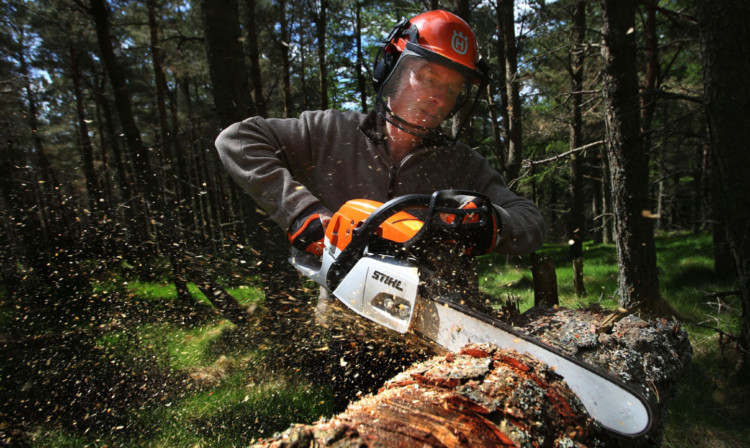Given all that is reported in the media, it might be expected that as chief executive of the leading forestry and timber trade body, I would be unable to agree with Nigel Miller of the NFUS on fundamental issues about land use in Scotland.
However, Nigel and I have had many positive discussions about cooperation and coexistence between farming and forestry in the best interests of rural Scotland and, through the Woodland Expansion Advisory Group (WEAG) process, I even thought we had agreed a way forward for forestry and farming.
That’s why I was disappointed with Nigel’s recent comments, reported in The Courier, arguing for a scaling down of forestry targets.
He said: “If farming, food and drink really is part of Scotland’s future, the option to inject new infrastructure, innovation, carbon efficiency and quality through pillar two must be grasped, even if that means scaling down forestry targets.”
No one questions the value of the food and drink sector to Scotland; it is a great success story.
But so is the forestry and timber sector, which supports 40,000 jobs and adds £1.7 billion in annual value to Scotland’s economy.
To present farming and forestry as either-or choices when it comes to land use and specifically in calling for forestry targets to be scaled down is to ignore the facts and to limit the choices and opportunities available to NFUS members.
When forestry experienced a huge expansion in planting in the 20th century, agricultural production actually rose, and a study for WEAG demonstrated that the Scottish Government’s current target of 100,000 hectares of new planting would reduce agricultural output by, at the very most, 2%.
Moreover, that study did not fully consider the significant production and animal health benefits that can be gained from integrating forestry and livestock farming.
During the era of greatest forestry expansion in Scotland, between 1960 and 1990, the total number of sheep in Scotland rose from 8.4 million to 9.9 million.
During the last decade, which has seen a big fall in breeding ewes, forest creation has been at an all-time low.
For many farmers, tree planting can be a viable and attractive option, and deliver significant economic benefits through shelter for animals, diversification of activity, a large future capital sum and an opportunity to make a big contribution to reducing carbon.
Let me be clear: Confor is not advocating covering prime agricultural land with trees, or seeking to blanket the hills with new planting. Our ambitions are modest, and they are good for Scotland.
In economic terms, forestry delivers more back to the land manager than much upland sheep farming, and generally pays higher wages good news for workers and the local economy.
Forestry is a very significant economic activity. This will be borne out by a major study which will be published soon.
Another Confor study showed increased domestic timber production has shifted the balance of payments by up to £1bn per year, a very significant economic impact.
In that light, I am uncertain why Nigel advocates a reduction in the funding available for planting trees when so many of his members could benefit.
He has quoted the Republic of Ireland as a model for Scotland. Yes, the Irish Government has focused on production support for farmers but successive Irish Governments have also provided significant funds for planting commercial forestry, a level of funding and ambition beyond what Confor has requested.
This has led to a huge expansion in the forest area in the last 15 years, which has been popular with much of the Republic’s farming community.
Forestry on lower-quality land provides diversification for farmers, a sound economic return and a significant contribution to meeting climate change targets another issue Nigel raised in his recent comments.
We all know about Scotland’s world-leading climate change ambitions, and forestry is central to this. From planting the tree to using the tree as a low-carbon, every-day material, forestry delivers a unique combination of income, jobs and carbon reduction.
Modern commercial forestry is an economic opportunity, but it is also designed to fit the landscape, provides homes for a wide range of flora and fauna, and can allow easy access for livestock to the upper hill. I am convinced that a rural balance can be achieved.
We are now talking about a modest target 6,000 hectares of new commercial planting each year for 10 years, which will provide long-term confidence of supply to the companies who make many of the products we all take for granted, such as timber frames for houses, fencing, furniture, pallets and decking.
There is also a genuine opportunity here for farmers to benefit economically.
Downgrading forestry would be bad for farmers, as well as bad for Scotland and disastrous for the forestry sector. As well as those 40,000 jobs and £1.7bn of added economic value, forestry is the only traditional business sector that takes more carbon out of the atmosphere the more active it is; more economic activity delivers more environmental benefit.
Our doors and our minds are always open, and I hope Nigel will come back with the kind of constructive dialogue we all need for rural Scotland to flourish.
* Stuart Goodall is chief executive of Confor: promoting forestry and wood: www.confor.org.uk.
